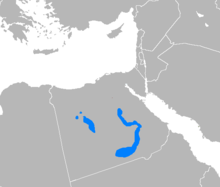lingvo.wikisort.org - Language
Ṣaʽīdi Arabic (autonym: صعيدى [sˤɑˈʕiːdi], Egyptian Arabic: [sˤeˈʕiːdi]), or Upper Egyptian Arabic,[3] is a variety of Arabic spoken by the Upper Egyptians in the area that is South/Upper Egypt, a strip of land on both sides of the Nile that extends from Aswan and downriver (northwards) to Lower Egypt.[4] It shares linguistic features with Egyptian Arabic, modern standard, and the Classical Arabic of the Quran. Dialects include Middle and Upper Egyptian Arabic.[5][6]
| Upper Egyptian Arabic (Saʽīdi Arabic) | |
|---|---|
| صعيدى | |
| Native to | Egypt |
Native speakers | 22.4 million (2016)[1] |
Language family | Afro-Asiatic
|
Writing system | Arabic alphabet |
| Language codes | |
| ISO 639-3 | aec |
| Glottolog | said1239 |
| Linguasphere | 12-AAC-eb[2] |
 | |
Speakers of Egyptian Arabic do not always understand more conservative varieties of Ṣaʽīdi Arabic.[7]
Ṣaʽīdi Arabic carries little prestige nationally, but it continues to be widely spoken in the South, and in the north by Southern migrants who have also adapted to Egyptian Arabic. For example, the Ṣaʽīdi genitive exponent is usually replaced with Egyptian bitāʿ, but the realisation of /q/ as [ɡ] is retained (normally realised in Egyptian Arabic as [ʔ]).
Saidi Arabic has various sub-dialects and varies widely from a town to town. Because of the tribal nature of Upper Egypt, and because some of the Upper Egyptian tribes have had links to the formal Arabic language with its proper pronunciations, or the classical Arabic language could be vividly noticed in many sub-dialects. For example, the word "قعمز" meaning "sit", is used throughout Egypt, Sudan, and the Maghreb, and continues to be widely used in Upper Egypt. Furthermore, in addition to similar pronunciation of letters with Hejazi cities such as Jeddah and Mecca, words such as "لسع" meaning "still" and "قمرية" meaning "wild pigeon" are in wide use in Upper Egypt. Other examples are classical words such as "فروج" meaning "chicken", as opposed to "فرخة" that is used in Northern Egypt.
Second- and third-generation Ṣaʽīdi migrants are monolingual in Egyptian Arabic but maintain cultural and family ties to the south.
The Egyptian poet Abdel Rahman el-Abnudi wrote in his native Sa'idi dialect and was the voice of the 2011 Egyptian Revolution and a prominent Egyptian Nationalist.
Phonology
Consonants
Ṣaʽīdi Arabic has the following consonants:[8]
| Bilabial | Dental | Alveolar | Palatal | Velar | Uvular | Pharyngeal | Glottal | ||
|---|---|---|---|---|---|---|---|---|---|
| Nasal | m | n | |||||||
| Plosive | voiceless | t | k | ʔ | |||||
| voiced | b | d | ɡ | ||||||
| Fricative | voiceless | f | s | ʃ | χ | ħ | h | ||
| voiced | z | ʁ | ʕ | ||||||
| Affricate | voiceless | t͡ʃ | |||||||
| voiced | d͡ʒ* | ||||||||
| Trill | r | ||||||||
| Approximant | w | l | j | ||||||
- ^* /d͡ʒ/ may also be realised as [ʒ] or as [d], when it merges with /d/.
Vowels
| Front | Central | Back | |
|---|---|---|---|
| High | i(ː) | u(ː) | |
| Mid | eː | oː | |
| Low | ä |
See also
- Varieties of Arabic
- Sa'idi people
- Copts
- Nubians
- Egyptian Arabic
References
- "Arabic, Sa'idi Spoken". Ethnologue. Retrieved 2018-08-08.
- "a" (PDF). The Linguasphere Register. p. 128. Retrieved 1 March 2013.
- "Arabic, Sa'idi Spoken". Ethnologue. Retrieved 1 March 2013.
- Versteegh, p. 163
- Orville Boyd Jenkins (2000-03-18). "Population Analysis of the Arabic Languages". Retrieved 2020-06-28.
- Bruce Ingham, "Some Characteristics of Meccan Speech", Bulletin of the School of Oriental and African Studies, University of London, Vol. 34, No. 2. (1971), pp. 273–297.
- Raymond G. Gordon Jr., ed. 2005. Ethnologue: Languages of the World. 15th edition. Dallas: Summer Institute of Linguistics.
- Khalafallah 1969
Sources
- Khalafallah, Abdelghany A. 1969. A Descriptive Grammar of Sa'i:di Egyptian Colloquial Arabic. Janua Linguarum, Series Practica 32. The Hague: Mouton.
- Versteegh, Kees (2001). The Arabic Language. Edinburgh: Edinburgh University Press. ISBN 0-7486-1436-2.
External links
На других языках
- [en] Saʽidi Arabic
[it] Lingua araba ṣa‘īdī
L'arabo ṣaʽīdī (in arabo: صعيدي /sˤɑˈʕiːdiː/, in arabo egiziano /sˤeˈʕiːdiː/), noto anche come arabo dell'Alto Egitto[2], è una varietà della lingua araba parlata dal popolo ṣaʽīdī nell'Alto Egitto, una striscia di terra su entrambe la rive del Nilo che, seguendo la direzione del fiume verso nord, si estende dalla Nubia fino al Basso Egitto[3]. Condivide somiglianze linguistiche con l'arabo egiziano, l'arabo sudanese e l'arabo classico del Corano. I suoi dialetti fanno parte dell'arabo parlato nel Medio e nell'Alto Egitto[4][5].[ru] Саидский диалект арабского языка
Саи́дский (верхнеегипетский) диалект арабского языка, саи́ди (саидск. صعيدى, [sˤɑˈʕiːdi]; масри [sˤeˈʕiːdi]) — одна из двух основных разновидностей арабского языка в Египте, распространённая на юге страны, на которой говорят около трети всех египтян.Другой контент может иметь иную лицензию. Перед использованием материалов сайта WikiSort.org внимательно изучите правила лицензирования конкретных элементов наполнения сайта.
WikiSort.org - проект по пересортировке и дополнению контента Википедии